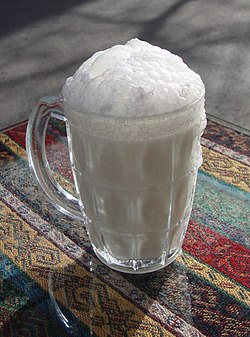Doogh
 Fresh Susurluk Ayranı with a head of froth | |
| Alternative names | Laban |
|---|---|
| Main ingredients | Yogurt, water |
Ayran or laban is a cold beverage of yogurt mixed with cold water and sometimes salt; it is popular in many Central Asian, Middle Eastern and South-eastern European countries.[1]
Similar and possibly related beverages include the South Asian lassi and the Iranian doogh.
Name
The name 'ayran' (turkish) is used in Turkish

- In Albanian it is called Dhallë,[2]
- In Arabic, it is called Leben 'ayrân (لبن عيران)
- In Armenian, it is called Tʻan (Թան)
- In Azerbaijanian, the same drink is called Airan (Ayran)
- In Assyrian Neo-Aramaic, it is called "dawghe"
- In Bulgarian, it is known as Ayryan or Ayran (Aйрян, Айран)[3]
- In Greek, Ariani (Aριάνι),[4] or Ayráni (Aϊράνι) or Xynógala (Ξυνόγαλα") (lit. "sour milk")
- In Afghanistan and Iran, the same drink, sometimes served with or without carbonation and is called Doogh (دوغ)
- In Iraqi Arabic, the same drink is called Shinēna.
- In Kurdish, the same drink, is called Dew or Do (depending on dialect)
- In Macedonian, it is called Ayran (Ајран)
- In Nepali, the same drink is called Mohi.
History
According to Turkish sources, ayran was developed by the Göktürks.[5][6] According to Iranian sources, ayran (doogh) dates to ancient Persia.[7]
Consumption and variations
Turkey
Consumption
Turkey is the biggest producer of ayran in the world,[8][9] and has researched the subject extensively.[10] In Turkey, ayran is often regarded as a separate category from other soft drinks.
International fast-food companies in Turkey, such as McDonald's and Burger King, include ayran on their menu.
In rural areas of Turkey, ayran is offered as a "standard" drink to guests.
Ayran is usually served chilled, and is a common accompaniment to any form of grilled meat, pastry, or rice.
Mainstream variations
- Susurluk ayranı - A very frothy kind of ayran, quite popular in Northwestern Turkey
- Yayık ayranı - An ayran that is hand stirred in big horizontal wooden churns. Thick, with close to no froth.
- Ekşili ayran - A sour variety, made out of strained yoghurt that carries a sour, smoky taste, especially if made from ewe's milk. Very popular in the Southeastern provinces.
Staple materials
- In Marmara and Ege Region, ayran is usually made with cow's milk.
- In Central Anatolia and along the Mediterranean coast, it is mostly made with ewe, and sometimes goat, milk.
- In the Black Sea Region, it is universally made of cow's milk.
- In the Eastern and Southeastern provinces, ewe's milk will dominate.
Albania
In Albania Ayran is called Dhallë. It is made from cow yoghurt mixed with water and is served salted and cold. You can buy it in the market, fast-food chains, Byrektore (A shop where Byrek is made). It is very popular in summer.
Middle East
Ayran also enjoys considerable popularity in the Middle East, where it remains widely available on the market. Leben 'ayrân is mostly made out of strained yoghurt and has a sourer taste than the mainstream Turkish Ayran
Bulgaria
Ayran is pronounced Ayryan and commonly consumed with fast food, such as Banitsa from street vendors.
Afghanistan
In the Persian speaking world, ayran, named "Dûğ / دوغ" is often drunk in a carbonated form. In rural Afghanistan, one will often be offered dûğ that is a lightly seasoned with different spices, such as cucumber or mint.
Pakistan
The Afghan refugees have introduced this beverage in Pakistan. As in Afghanistan. it is known as Doogh "Dûğ / دوغ".
See also
Similar beverages:
References
- ^ Heyhoe, Kate. The ABC's of Larousse Gastronomique : ayran
- ^ Albanian-Turkish Dictionary Fjalor turqisht-shqip Indiana University 2009 [1]
- ^ Merriam-Webster Unabridged Dictionary - airan
- ^ Dictionary of Standard Modern Greek - αριάνι
- ^ http://www.sutdunyasi.com/eski/s9/kapak.htm It is explained that the Göktürks naturally came across the Ayran while diluting it with water in order to reduce it's sourness.
- ^ http://www.kultur.gov.tr/TR/belge/1-17518/mutfak-kulturumuzde-turk-icecekleri-mesrubatlari.html Turkish Ministry of Culture - Article on the Turkish Culinary Culture - See the "Ayran" entry where this relation is thoroughly explained.
- ^ Simmons, Shirin (2007). Treasury of Persian Cuisine. Stamford House Publishing. ISBN 1-904985-56-4, 9781904985563.
{{cite book}}: Check|isbn=value: invalid character (help) - ^ The manufactured Ayran market of Turkey was of 67.000.000 YTL as of 2006
- ^ http://goliath.ecnext.com/coms2/gi_0199-7224497/Entering-a-new-phase-David.html
- ^ http://www.sciencedirect.com/science?_ob=ArticleURL&_udi=B6T7C-490H165-1&_user=10&_coverDate=12%2F31%2F2003&_rdoc=1&_fmt=high&_orig=gateway&_origin=gateway&_sort=d&_docanchor=&view=c&_searchStrId=1691242559&_rerunOrigin=google&_acct=C000050221&_version=1&_urlVersion=0&_userid=10&md5=6691082a7a3bad53fb796ca823e38f93&searchtype=a
